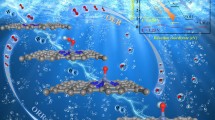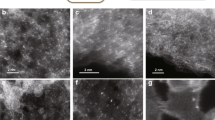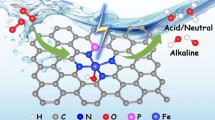Abstract
Developing highly active iron-nitrogen-carbon catalysts for electrocatalytic oxygen reduction reactions (ORR) is pivotal to future energy technology. The penta-coordinated Fe-N-C with an augmented activity toward the oxygen reduction has been regarded as one of the promising candidates to replace platinum-based ORR catalysts. However, the lack of pertinent fundamental understanding hinders further optimizing the catalytic activity of such catalysts. Herein, through density functional theory (DFT) calculations, we systematically investigated the catalytic activity and ligand/metal coordination effects of 17 penta-coordinated Fe-N-C catalysts (labeled as FeNC-Xs, X denotes axial ligand). Our results not only show the theoretical overpotential of FeNC-Xs is lower than that of conventional tetra-coordinated Fe-N-C catalysts (labeled as FeNC), verifying the preeminent performance of FeNC-Xs, but also further indicate that the axial coordination effect of X ligands can decrease the orbital hybridization of Fe active center with ORR-relevant intermediates, sequentially accelerating the ORR. More importantly, we reveal that the catalytic activity of FeNC-Xs increases with a decreased electronegativity of X ligands, which can be utilized to describe the axial coordination effect for FeNC-Xs. These findings can deeply advance the understanding of penta-coordinated iron-nitrogen-carbon catalysts, which provide timely guidelines for designing optimum Fe-N-C based catalysts.

Similar content being viewed by others
References
Chen, C.; Kang, Y. J.; Huo, Z. Y.; Zhu, Z. W.; Huang, W. Y.; Xin, H. L.; Snyder, J. D.; Li, D. G.; Herron, J. A.; Mavrikakis, M. et al. Highly crystalline multimetallic nanoframes with three-dimensional electrocatalytic surfaces. Science 2014, 343, 1339–1343.
Gao, F.; Zhao, G. L.; Wang, Z.; Bagayoko, D.; Liu, D. J. Catalytic reaction on FeN4/C site of nitrogen functionalized carbon nanotubes as cathode catalyst for hydrogen fuel cells. Catal. Commun. 2015, 62, 79–82.
Nie, Y.; Li, L.; Wei, Z. D. Recent advancements in Pt and Pt-free catalysts for oxygen reduction reaction. Chem. Soc. Rev. 2015, 44, 2168–2201.
Bing, Y. H.; Liu, H. S.; Zhang, L.; Ghosh, D.; Zhang, J. J. Nanostructured Pt-alloy electrocatalysts for PEM fuel cell oxygen reduction reaction. Chem. Soc. Rev. 2010, 39, 2184–2202.
Greeley, J.; Stephens, I. E. L.; Bondarenko, A. S.; Johansson, T. P.; Hansen, H. A.; Jaramillo, T. F.; Rossmeisl, J.; Chorkendorff, I.; Nørskov, J. K. Alloys of platinum and early transition metals as oxygen reduction electrocatalysts. Nat. Chem. 2009, 1, 552–556.
Dou, S.; Wang, X.; Wang, S. Y. Rational design of transition metal-based materials for highly efficient electrocatalysis. Small Methods 2019, 3, 1800211.
Ma, R. G.; Lin, G. X.; Zhou, Y.; Liu, Q.; Zhang, T.; Shan, G. C.; Yang, M. H.; Wang, J. C. A review of oxygen reduction mechanisms for metal-free carbon-based electrocatalysts. npj Comput. Mater. 2019, 5, 78.
Wu, G.; More, K. L.; Johnston, C. M.; Zelenay, P. High-performance electrocatalysts for oxygen reduction derived from polyaniline, iron, and cobalt. Science 2011, 332, 443–447.
Proietti, E.; Jaouen, F.; Lefèvre, M.; Larouche, N.; Tian, J.; Herranz, J.; Dodelet, J. P. Iron-based cathode catalyst with enhanced power density in polymer electrolyte membrane fuel cells. Nat. Commun. 2011, 2, 416.
Wu, G. Current challenge and perspective of PGM-free cathode catalysts for PEM fuel cells. Front. Energy 2017, 11, 286–298.
Zhao, L.; Zhang, Y.; Huang, L. B.; Liu, X. Z.; Zhang, Q. H.; He, C.; Wu, Z. Y.; Zhang, L. J.; Wu, J. P.; Yang, W. L. et al. Cascade anchoring strategy for general mass production of high-loading single-atomic metal-nitrogen catalysts. Nat. Commun. 2019, 10, 1278.
Li, L. L.; Chang, X.; Lin, X. Y.; Zhao, Z. J.; Gong, J. L. Theoretical insights into single-atom catalysts. Chem. Soc. Rev. 2020, 49, 8156–8178.
Song, Z. X.; Zhang, L.; Doyle-Davis, K.; Fu, X. Z.; Luo, J. L.; Sun, X. L. Recent advances in MOF-derived single atom catalysts for electrochemical applications. Adv. Energy Mater. 2020, 10, 2001561.
Li, Y. C.; Liu, X. F.; Zheng, L. R.; Shang, J. X.; Wan, X.; Hu, R. M.; Guo, X.; Hong, S.; Shui, J. L. Preparation of Fe−N−C catalysts with FeNx (x = 1, 3, 4) active sites and comparison of their activities for the oxygen reduction reaction and performances in proton exchange membrane fuel cells. J. Mater. Chem. A 2019, 7, 26147–26153.
Gong, L. Y.; Zhang, H.; Wang, Y.; Luo, E. G.; Li, K.; Gao, L. Q.; Wang, Y. M.; Wu, Z. J.; Jin, Z.; Ge, J. J. et al. Bridge bonded oxygen ligands between approximated FeN4 sites confer the catalysts with high ORR performance. Angew. Chem., Int. Ed. 2020, 59, 13923–13928.
Han, Y. H.; Wang, Y. G.; Xu, R. R.; Chen, W. X.; Zheng, L. R.; Han, A. J.; Zhu, Y. Q.; Zhang, J.; Zhang, H.; Luo, J. et al. Electronic structure engineering to boost oxygen reduction activity by controlling the coordination of the central metal. Energy Environ. Sci. 2018, 11, 2348–2352.
Zhao, C. X.; Li, B. Q.; Liu, J. N.; Zhang, Q. Intrinsic electrocatalytic activity regulation of M-N-C single-atom catalysts for the oxygen reduction reaction. Angew. Chem., Int. Ed. 2021, 60, 4448–4463.
Wan, C. Z.; Duan, X. F.; Huang, Y. Molecular design of single-atom catalysts for oxygen reduction reaction. Adv. Energy Mater. 2020, 10, 1903815.
Wang, X.; Jia, Y.; Mao, X.; Liu, D. B.; He, W. X.; Li, J.; Liu, J. G.; Yan, X. C.; Chen, J.; Song, L. et al. Edge-rich Fe-N4 active sites in defective carbon for oxygen reduction catalysis. Adv. Mater. 2020, 32, 2000966.
Jiang, R.; Li, L.; Sheng, T.; Hu, G. F.; Chen, Y. G.; Wang, L. Y. Edge-site engineering of atomically dispersed Fe-N4 by selective C-N bond cleavage for enhanced oxygen reduction reaction activities. J. Am. Chem. Soc. 2018, 140, 11594–11598.
Ma, R. G.; Lin, G. X.; Ju, Q. J.; Tang, W.; Chen, G.; Chen, Z. H.; Liu, Q.; Yang, M. H.; Lu, Y. F.; Wang, J. C. Edge-sited Fe-N4 atomic species improve oxygen reduction activity via boosting O2 dissociation. Appl. Catal. B: Environ. 2020, 265, 118593.
Zhu, X. F.; Zhang, D. T.; Chen, C. J.; Zhang, Q. R.; Liu, R. S.; Xia, Z. H.; Dai, L. M.; Amal, R.; Lu, X. Y. Harnessing the interplay of Fe-Ni atom pairs embedded in nitrogen-doped carbon for bifunctional oxygen electrocatalysis. Nano Energy 2020, 71, 104597.
Li, H. X.; Wen, Y. L.; Jiang, M.; Yao, Y.; Zhou, H. H.; Huang, Z. Y.; Li, J. W.; Jiao, S. Q.; Kuang, Y. F.; Luo, S. L. Understanding of neighboring Fe−N4−C and Co−N4−C dual active centers for oxygen reduction reaction. Adv. Funct. Mater. 2021, 31, 2011289.
Zheng, X. N.; Yao, Y.; Wang, Y.; Liu, Y. Tuning the electronic structure of transition metals embedded in nitrogen-doped graphene for electrocatalytic nitrogen reduction: A first-principles study. Nanoscale 2020, 12, 9696–9707.
Li, Q. H.; Chen, W. X.; Xiao, H.; Gong, Y.; Li, Z.; Zheng, L. R.; Zheng, X. S.; Yan, W. S.; Cheong, W. C.; Shen, R. O. et al. Fe isolated single atoms on S, N codoped carbon by copolymer pyrolysis strategy for highly efficient oxygen reduction reaction. Adv. Mater. 2018, 30, 1800588.
Chen, Y. J.; Ji, S. F.; Zhao, S.; Chen, W. X.; Dong, J. C.; Cheong, W. C.; Shen, R. A.; Wen, X. D.; Zheng, L. R.; Rykov, A. I. et al. Enhanced oxygen reduction with single-atomic-site iron catalysts for a zinc-air battery and hydrogen-air fuel cell. Nat. Commun. 2018, 9, 5422.
Zhou, Y. Z.; Tao, X. F.; Chen, G. B.; Lu, R. H.; Wang, D.; Chen, M. X.; Jin, E. Q.; Yang, J.; Liang, H. W.; Zhao, Y. et al. Multilayer stabilization for fabricating high-loading single-atom catalysts. Nat. Commun. 2020, 11, 5892.
Tylus, U.; Jia, Q. Y.; Strickland, K.; Ramaswamy, N.; Serov, A.; Atanassov, P.; Mukerjee, S. Elucidating oxygen reduction active sites in pyrolyzed metal-nitrogen coordinated non-precious-metal electrocatalyst systems. J. Phys. Chem. C 2014, 118, 8999–9008.
Mun, Y.; Lee, S.; Kim, K.; Kim, S.; Lee, S.; Han, J. W.; Lee, J. Versatile strategy for tuning ORR activity of a single Fe-N4 site by controlling electron-withdrawing/donating properties of a carbon plane. J. Am. Chem. Soc. 2019, 141, 6254–6262.
Lin, Y. C.; Liu, P. Y.; Velasco, E.; Yao, G.; Tian, Z. Q.; Zhang, L. J.; Chen, L. Fabricating single-atom catalysts from chelating metal in open frameworks. Adv. Mater. 2019, 31, 1808193.
Yang, X.; Xia, D. S.; Kang, Y. Q.; Du, H. D.; Kang, F. Y.; Gan, L.; Li, J. Unveiling the axial hydroxyl ligand on Fe-N4-C electrocatalysts and its impact on the Ph-dependent oxygen reduction activities and poisoning kinetics. Adv. Sci. 2020, 7, 2000176.
Wang, Y.; Tang, Y. J.; Zhou, K. Self-adjusting activity induced by intrinsic reaction intermediate in Fe-N-C single-atom catalysts. J. Am. Chem. Soc. 2019, 141, 14115–14119.
Chen, Z. Q.; Huang, A. J.; Yu, K.; Cui, T. T.; Zhuang, Z. W.; Liu, S. J.; Li, J. Z.; Tu, R. Y.; Sun, K. A.; Tan, X. et al. Fe1N4−O1 site with axial Fe−O coordination for highly selective CO2 reduction over a wide potential range. Energy Environ. Sci. 2021, 14, 3430–3437.
Zhang, H. N.; Li, J.; Xi, S. B.; Du, Y. H.; Hai, X.; Wang, J. Y.; Xu, H. M.; Wu, G.; Zhang, J.; Lu, J. et al. A graphene-supported singleatom FeN5 catalytic site for efficient electrochemical CO2 reduction. Angew. Chem., Int. Ed. 2019, 58, 14871–14876.
Chen, H. H.; Guo, X.; Kong, X. D.; Xing, Y. L.; Liu, Y.; Yu, B. L.; Li, Q. X.; Geng, Z. G.; Si, R.; Zeng, J. Tuning the coordination number of Fe single atoms for the efficient reduction of CO2. Green Chem. 2020, 22, 7529–7536.
Xin, C. C.; Shang, W. Z.; Hu, J. W.; Zhu, C.; Guo, J. Y.; Zhang, J. W.; Dong, H. P.; Liu, W.; Shi, Y. T. Integration of morphology and electronic structure modulation on atomic iron-nitrogen-carbon catalysts for highly efficient oxygen reduction. Adv. Funct. Mater. 2022, 32, 2108345.
Hu, L. Y.; Dai, C. L.; Chen, L. W.; Zhu, Y. H.; Hao, Y. C.; Zhang, Q. H.; Gu, L.; Feng, X.; Yuan, S.; Wang, L. et al. Metal-triazolate-framework-derived FeN4Cl1 single-atom catalysts with hierarchical porosity for the oxygen reduction reaction. Angew. Chem., Int. Ed. 2021, 60, 27324–27329.
Li, Z.; Wu, R.; Xiao, S. H.; Yang, Y. C.; Lai, L.; Chen, J. S.; Chen, Y. Axial chlorine coordinated iron-nitrogen-carbon single-atom catalysts for efficient electrochemical CO2 reduction. Chem. Eng. J. 2022, 430, 132882.
Lin, L.; Li, H. B.; Yan, C. C.; Li, H. F.; Si, R.; Li, M. R.; Xiao, J. P.; Wang, G. X.; Bao, X. H. Synergistic catalysis over iron-nitrogen sites anchored with cobalt phthalocyanine for efficient CO2 electroreduction. Adv. Mater. 2019, 31, 1903470.
Kohn, W.; Sham, L. J. Self-consistent equations including exchanger and correlation effects. Phys. Rev. 1965, 140, A1133–A1138.
Kresse, G.; Furthmüller, J. Efficiency of ab-initio total energy calculations for metals and semiconductors using a plane-wave basis set. Comput. Mater. Sci. 1996, 6, 15–50.
Kresse, G.; Furthmüller, J. Efficient iterative schemes for ab initio total-energy calculations using a plane-wave basis set. Phys. Rev. B 1996, 54, 11169–11186.
Perdew, J. P.; Burke, K.; Ernzerhof, M. Generalized gradient approximation made simple. Phys. Rev. Lett. 1996, 77, 3865–3868.
Kresse, G.; Joubert, D. From ultrasoft pseudopotentials to the projector augmented-wave method. Phys. Rev. B 1999, 59, 1758–1775.
Grimme, S.; Antony, J.; Ehrlich, S.; Krieg, H. A consistent and accurate ab initio parametrization of density functional dispersion correction (DFT-D) for the 94 elements H-Pu. J. Chem. Phys. 2010, 132, 154104.
Monkhorst, H. J.; Pack, J. D. Special points for Brillouin-zone integrations. Phys. Rev. B 1976, 13, 5188–5192.
Henkelman, G.; Arnaldsson, A.; Jónsson, H. A fast and robust algorithm for Bader decomposition of charge density. Comput. Mater. Sci. 2006, 36, 354–360.
Liu, Y.; Tuckerman, M. E. Generalized Gaussian moment thermostatting: A new continuous dynamical approach to the canonical ensemble. J. Chem. Phys. 2000, 112, 1685–1700.
Deringer, V. L.; Tchougréeff, A. L.; Dronskowski, R. Crystal orbital Hamilton population (COHP) analysis as projected from plane-wave basis sets. J. Phys. Chem. A 2011, 115, 5461–5466.
Wang, V.; Xu, N.; Liu, J. C.; Tang, G.; Geng, W. T. VASPKIT: A user-friendly interface facilitating high-throughput computing and analysis using VASP code. Comput. Phys. Commun. 2021, 267, 108033.
Momma, K.; Izumi, F. VESTA: A three-dimensional visualization system for electronic and structural analysis. J. Appl. Cryst. 2008, 41, 653–658.
Nørskov, J. K.; Rossmeisl, J.; Logadottir, A.; Lindqvist, L.; Kitchin, J. R.; Bligaard, T.; Jónsson, H. Origin of the overpotential for oxygen reduction at a fuel-cell cathode. J. Phys. Chem. B 2004, 108, 17886–17892.
Xie, Z. M.; Chen, M. W.; Peera, S. G.; Liu, C.; Yang, H.; Qi, X. P.; Kumar, U. P.; Liang, T. X. Theoretical study on a nitrogen-doped graphene nanoribbon with edge defects as the electrocatalyst for oxygen reduction reaction. ACS Omega 2020, 5, 5142–5149.
Yan, M.; Dai, Z. X.; Chen, S. N.; Dong, L. J.; Zhang, X. L.; Xu, Y. J.; Sun, C. H. Single-iron supported on defective graphene as efficient catalysts for oxygen reduction reaction. J. Phys. Chem. C 2020, 124, 13283–13290.
Gallenkamp, C.; Kramm, U. I.; Krewald, V. Spectroscopic discernibility of dopants and axial ligands in pyridinic FeN4 environments relevant to single-atom catalysts. Chem. Commun. 2021, 57, 859–862.
Yang, X. F.; Wang, A. Q.; Qiao, B. T.; Li, J.; Liu, J. Y.; Zhang, T. Single-atom catalysts: A new frontier in heterogeneous catalysis. Acc. Chem. Res. 2013, 46, 1740–1748.
Jain, D.; Zhang, Q.; Gustin, V.; Hightower, J.; Gunduz, S.; Co, A. C.; Miller, J. T.; Asthagiri, A.; Ozkan, U. S. Experimental and DFT investigation into chloride poisoning effects on nitrogen-coordinated iron-carbon (FeNC) catalysts for oxygen reduction reaction. J. Phys. Chem. C 2020, 124, 10324–10335.
Xu, H.; Wang, D.; Yang, P. X.; Liu, A. M.; Li, R. P.; Li, Y.; Xiao, L. H.; Zhang, J. Q.; An, M. Z. A theoretical study of atomically dispersed MN4/C (M = Fe or Mn) as a high-activity catalyst for the oxygen reduction reaction. Phys. Chem. Chem. Phys. 2020, 22, 28297–28303.
Shang, R.; Steinmann, S. N.; Xu, B. Q.; Sautet, P. Mononuclear Fe in N-doped carbon: Computational elucidation of active sites for electrochemical oxygen reduction and oxygen evolution reactions. Catal. Sci. Technol. 2020, 10, 1006–1014.
Kim, D.; Shi, J. J.; Liu, Y. Y. Substantial impact of charge on electrochemical reactions of two-dimensional materials. J. Am. Chem. Soc. 2018, 140, 9127–9131.
Zhao, X. H.; Liu, Y. Y. Unveiling the active structure of single nickel atom catalysis: Critical roles of charge capacity and hydrogen bonding. J. Am. Chem. Soc. 2020, 142, 5773–5777.
Zhao, X. H.; Liu, Y. Y. Origin of selective production of hydrogen peroxide by electrochemical oxygen reduction. J. Am. Chem. Soc. 2021, 143, 9423–9428.
Man, I. C.; Su, H. Y.; Calle-Vallejo, F.; Hansen, H. A.; Martínez, J. I.; Inoglu, N. G.; Kitchin, J.; Jaramillo, T. F.; Nørskov, J. K.; Rossmeisl, J. Universality in oxygen evolution electrocatalysis on oxide surfaces. ChemCatChem 2011, 3, 1159–1165.
Wannakao, S.; Maihom, T.; Kongpatpanich, K.; Limtrakul, J.; Promarak, V. Halogen substitutions leading to enhanced oxygen evolution and oxygen reduction reactions in metalloporphyrin frameworks. Phys. Chem. Chem. Phys. 2017, 19, 29540–29548.
Hu, R. M.; Li, Y. C.; Wang, F. H.; Shang, J. X. Rational prediction of multifunctional bilayer single atom catalysts for the hydrogen evolution, oxygen evolution and oxygen reduction reactions. Nanoscale 2020, 12, 20413–20424.
Kulkarni, A.; Siahrostami, S.; Patel, A.; Nørskov, J. K. Understanding catalytic activity trends in the oxygen reduction reaction. Chem. Rev. 2018, 118, 2302–2312.
Liao, X. B.; Lu, R. H.; Xia, L. X.; Liu, Q.; Wang, H.; Zhao, K.; Wang, Z. Y.; Zhao, Y. Density functional theory for electrocatalysis. Energy Environ. Mater. 2022, 5, 157–185.
Rossmeisl, J.; Qu, Z. W.; Zhu, H.; Kroes, G. J.; Nørskov, J. K. Electrolysis of water on oxide surfaces. J. Electroanal. Chem. 2007, 607, 83–89.
Seo, M. H.; Higgins, D.; Jiang, G. P.; Choi, S. M.; Han, B.; Chen, Z. W. Theoretical insight into highly durable iron phthalocyanine derived non-precious catalysts for oxygen reduction reactions. J. Mater. Chem. A 2014, 2, 19707–19716.
Sun, Y. M.; Sun, S. N.; Yang, H. T.; Xi, S. B.; Gracia, J.; Xu, Z. J. Spin-related electron transfer and orbital interactions in oxygen electrocatalysis. Adv. Mater. 2020, 32, 2003297.
Liu, W. G.; Zhang, L. L.; Liu, X.; Liu, X. Y.; Yang, X. F.; Miao, S.; Wang, W. T.; Wang, A. Q.; Zhang, T. Discriminating catalytically active FeNx species of atomically dispersed Fe-N-C catalyst for selective oxidation of the C-H bond. J. Am. Chem. Soc. 2017, 139, 10790–10798.
Ramaswamy, N.; Tylus, U.; Jia, Q. Y.; Mukerjee, S. Activity descriptor identification for oxygen reduction on nonprecious electrocatalysts: Linking surface science to coordination chemistry. J. Am. Chem. Soc. 2013, 135, 15443–15449.
Putz, M. V.; Russo, N.; Sicilia, E. About the Mulliken electronegativity in DFT. Theor. Chem. Acc. 2005, 114, 38–45.
Acknowledgments
The work in this paper was supported in part by Foshan Xianhu Laboratory of the Advanced Energy Science and Technology Guangdong Laboratory (No. XHT2020-003), the China Postdoctoral Science Foundation (No. 2021M692490), and the Fundamental Research Funds for the Central Universities (No. WUT:2020III029, 2020IVA100).
Author information
Authors and Affiliations
Corresponding authors
Electronic Supplementary Material
Rights and permissions
About this article
Cite this article
Lu, R., Quan, C., Zhang, C. et al. Establishing a theoretical insight for penta-coordinated iron-nitrogen-carbon catalysts toward oxygen reaction. Nano Res. 15, 6067–6075 (2022). https://doi.org/10.1007/s12274-022-4318-2
Received:
Revised:
Accepted:
Published:
Issue Date:
DOI: https://doi.org/10.1007/s12274-022-4318-2




